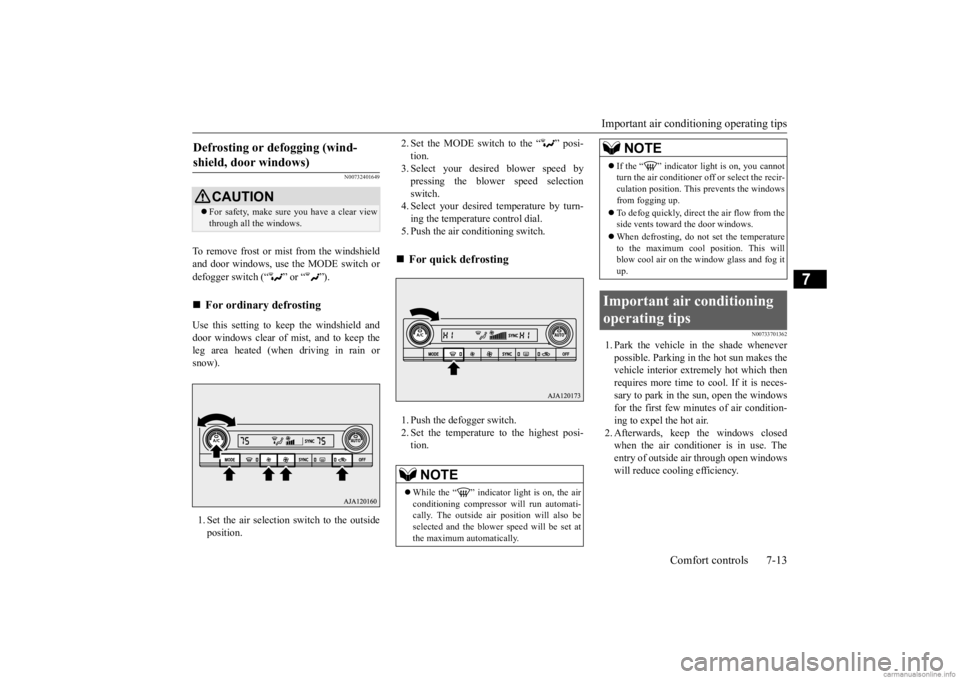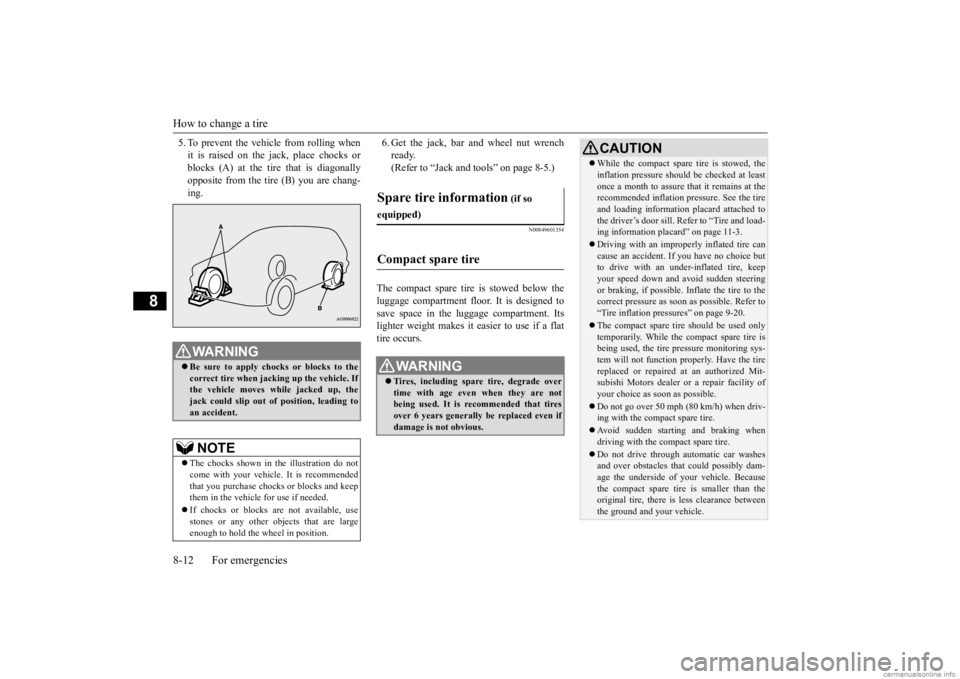Set the time MITSUBISHI OUTLANDER 2020 (in English) Service Manual
[x] Cancel search | Manufacturer: MITSUBISHI, Model Year: 2020, Model line: OUTLANDER, Model: MITSUBISHI OUTLANDER 2020Pages: 443, PDF Size: 60.03 MB
Page 350 of 443

Important air conditioning operating tips
Comfort controls 7-13
7
N00732401649
To remove frost or mist from the windshield and door windows, use the MODE switch or defogger switch (“ ” or “ ”). Use this setting to ke
ep the windshield and
door windows clear of mist, and to keep theleg area heated (when driving in rain or snow). 1. Set the air selection
switch to the outside
position.
2. Set the MODE switch to the “ ” posi- tion. 3. Select your desired blower speed bypressing the blower speed selection switch. 4. Select your desired temperature by turn-ing the temperature control dial. 5. Push the air conditioning switch. 1. Push the defogger switch. 2. Set the temperature to the highest posi- tion.
N00733701362
1. Park the vehicle in the shade whenever possible. Parking in the hot sun makes the vehicle interior extremely hot which thenrequires more time to cool. If it is neces- sary to park in the sun, open the windows for the first few minutes of air condition-ing to expel the hot air. 2. Afterwards, keep the windows closed when the air conditioner is in use. Theentry of outside air through open windows will reduce cooling efficiency.
Defrosting or defogging (wind- shield, door windows)
CAUTION For safety, make sure you have a clear view through all the windows.
For ordinary defrosting
For quick defrosting NOTE
While the “ ” indicator light is on, the air conditioning compressor
will run automati-
cally. The outside air
position will also be
selected and the blower
speed will be set at
the maximum au
tomatically.
If the “ ” indicator light is on, you cannot turn the air conditioner of
f or select the recir-
culation position. This prevents the windowsfrom fogging up. To defog quickly, direct the air flow from the side vents toward the door windows. When defrosting, do not set the temperature to the maximum cool position. This will blow cool air on the
window glass and fog it
up.
Important air conditioning operating tips
NOTE
BK0278200US.book 13 ページ 2019年4月10日 水曜日 午前10時59分
Page 364 of 443

How to change a tire
For emergencies 8-11
8
17. After driving for 10 minutes or 3 miles (5
km), park the vehicl
e in a safe place.
Remove the air compressor from the stowed position. Check the tire pressureusing the air pressure gauge on the com- pressor. If the tire pressure has not dropped, the emergency repair procedureis complete. Proceed to step 19. If the tire pressure is insufficient, inflate the tire to the specified pressure again anddrive the vehicle carefully without exceeding a speed of 50 mph (80 km/h). Before driving, make sure that the com-pressor is stowed.
18. After driving for 10 minutes or 3 miles (5
km) again, check the tire pressure usingthe air pressure gauge on the compressor. If the tire pressure has not dropped, the emergency repair procedure is complete.Before driving, make sure that the com- pressor is stowed. You must still not exceed a speed of 50 mph (80 km/h).Observe local speed limits.
19. Immediately drive with great care to an
authorized Mitsubishi
Motors dealer and
have the tire repa
ir/replacement per-
formed.
N00836901829
Before changing a tire,
first stop your vehicle
in a safe, flat location. 1. Park the vehicle on level and stable ground. 2. Set the parking brake firmly. 3. Move the selector lever to the “P”(PARK) position and turn the ignition switch (the engine switch) to the “LOCK” or “OFF” position.4. Turn on the hazard warning flashers and set up a warning sign, such as a warning triangle or flashing signal lamp, at an ade-quate distance from the vehicle, and have all your passengers
leave the vehicle.
CAUTIONIf you sense any abnormality while driving, stop the vehicle and c
ontact an authorized
Mitsubishi Motors dealer. Otherwise the tirepressure may drop before the emergency repair procedure is completed, rendering the vehicle unsafe to drive.CAUTION If the tire pressure is lower than the mini- mum permitted pressure (18 psi {130 kPa}), the tire cannot successf
ully be repaired with
the tire sealant. Do not drive the vehicle anyfurther. Contact an authorized Mitsubishi Motors dealer.
NOTE
If the tire pressure has dropped below the specified level when you check it at the end of the repair procedure, do not drive the vehicle any further.
Contact an authorized
Mitsubishi Moto
rs dealer.
In cold conditions (when the ambient tem- perature is 32 °F {0 °C} or lower), the time and driving distance required until comple- tion of the repair can
become longer than in
warmer conditions, and the tire pressure may drop below the specified level even after you have inflated the tire the second time andsubsequently driven the vehicle. If this hap- pens, inflate the tire to the specified pressure once more, drive for approximately 10 min-utes or 3 miles (5 km), then check the tire pressure again. If the tire pressure has again dropped below the specified level, stop driv-ing the vehicle and contact an authorized Mitsubishi Moto
rs dealer.
NOTE
Please give the empt
y sealant bottle to an
authorized Mitsubishi Motors dealer or dis-pose of the sealant bot
tle according to regu-
lations for the disposal
of chemical waste.
To purchase a new tire
sealant bottle, contact
an authorized Mitsubishi Motors dealer.
How to change a tire
BK0278200US.book 11 ページ 2019年4月10日 水曜日 午前10時59分
Page 365 of 443

How to change a tire 8-12 For emergencies
8
5. To prevent the vehicle from rolling when it is raised on the jack, place chocks orblocks (A) at the ti
re that is diagonally
opposite from the tire (B) you are chang- ing.
6. Get the jack, bar and wheel nut wrench ready.(Refer to “Jack and t
ools” on page 8-5.)
N00849601354
The compact spare tire is stowed below the luggage compartment floor. It is designed to save space in the luggage compartment. Its lighter weight ma
kes it easier to use if a flat
tire occurs.
WA R N I N G Be sure to apply choc
ks or blocks to the
correct tire when jacking up the vehicle. If the vehicle moves while jacked up, the jack could slip out of
position, leading to
an accident.NOTE
The chocks shown in the illustration do not come with your vehicle. It is recommended that you purchase chocks
or blocks and keep
them in the vehicle for use if needed. If chocks or blocks ar
e not available, use
stones or any other obj
ects that are large
enough to hold the wheel in position.
Spare tire information
(if so
equipped)Compact spare tire
WA R N I N G Tires, including spar
e tire, degrade over
time with age even when they are not being used. It is recommended that tires over 6 years generally
be replaced even if
damage is not obvious.
CAUTION While the compact spare tire is stowed, the inflation pressure shoul
d be checked at least
once a month to assure that it remains at therecommended inflation pressure. See the tire and loading information placard attached to the driver’s door sill. Refer to “Tire and load-ing information placard” on page 11-3. Driving with an imprope
rly inflated tire can
cause an accident. If
you have no choice but
to drive with an under-inflated tire, keep your speed down and av
oid sudden steering
or braking, if possible. Inflate the tire to the correct pressure as soon as possible. Refer to “Tire inflation pressures” on page 9-20. The compact spare tire should be used only temporarily. While th
e compact spare tire is
being used, the tire pr
essure monitoring sys-
tem will not function pr
operly. Have the tire
replaced or repaired at an authorized Mit-subishi Motors dealer or a repair facility of your choice as soon as possible. Do not go over 50 mph (80 km/h) when driv- ing with the compact spare tire. Avoid sudden starting and braking when driving with the
compact spare tire.
Do not drive through automatic car washes and over obstacles that
could possibly dam-
age the underside of your vehicle. Becausethe compact spare tire is smaller than the original tire, there is less clearance between the ground and your vehicle.
BK0278200US.book 12 ページ 2019年4月10日 水曜日 午前10時59分
Page 372 of 443

Operation under adverse driving conditions
For emergencies 8-19
8
Release the parking brake. Set the selector lever to the “N” (NEUTRAL) position.
N00837201760
If your vehicle becomes
stuck in snow, sand,
or mud, it can often be moved by a rocking motion. Rock your vehicle back and forth to free it.Do not rev the engine or spin the wheels. Constant efforts to free a stuck vehicle can cause overheating and tr
ansaxle failure. Let
the engine idle for a few minutes to cool the transaxle before trying again. If your vehicle is still
stuck after several rock-
ing attempts, call for a commercial tow truck service.
[For front-wheel driv
e vehicle equipped with
the active stability control (ASC)]If the vehicle is towed with the ignitionswitch in the “ON” pos
ition or the operation
mode in ON and only the front wheels raised off the ground (Type C), the ASC may oper-ate, resulting in an accident. When towing the vehicle with the front wheels raised, keep the ignition switch or
the operation mode as
follows. [Except for vehicles equipped with the F. A . S . T. - k e y ]The ignition switch is in “LOCK”, “OFF” or “ACC” position. [Vehicles equipped with the F.A.S.T.-key]The operation mode is in OFF or ACC.
Towing a front-wheel drive vehi- cle with front wheels off the ground (Type C)
CAUTION
Operation under adverse driving conditions If your vehicle becomes stuck in sand, mud or snow
WA R N I N G When trying to rock
your vehicle out of a
stuck position, make sure that there are nopeople nearby. The
rocking motion can
make your vehicle suddenly lurch forward or backward, and inju
re any bystanders.
On wet roads
CAUTIONAvoid flooded roads. Water is often deeper than it looks, and you could be seriously hurtby driving into flood water. When driving in rain, on water-covered roads, or through a car
wash, water could get
into the brake discs and make them fail tem- porarily. In such cases, lightly press thebrake pedal to see if they are working prop- erly. If they are not, press the pedal lightly several times while driving to dry the brakepads or linings, then check them again. When driving in rain, a layer of water may form between the tires and the road surface (hydroplaning). This loosens your tires’ grip on the road, making it difficult to steer orbrake properly. When driving on a wet road:• Drive your vehicle at a safe speed.• Do not drive on worn tires.• Always keep the tires at the correct infla- tion pressures.
BK0278200US.book 19 ページ 2019年4月10日 水曜日 午前10時59分